Maevia inclemens, commonly called dimorphic jumper is a species of jumping spiders mainly found in the Eastern U.S. States and Southeastern Canada. Its common name comes from the fact that there are two types of males that differ in appearance and behavior – so-called morphs.
Dimorphic Jumper Description
As mentioned, the male dimorphic jumper comes in two forms (or morphs): the dark morph with a completely black abdomen and cephalothorax and white legs.
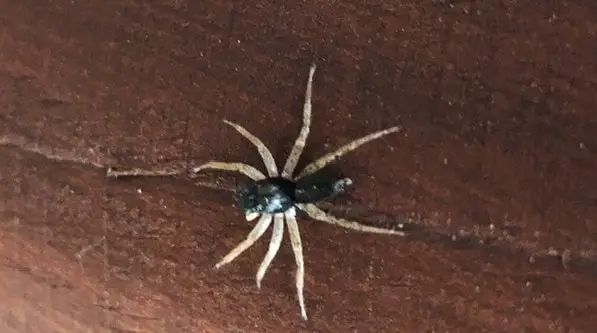
The gray morph has gray and white stripes along its body and legs. It is therefore sometimes confused with the gray wall jumper or the zebra jumping spider. However, the gray morph of maevia inclemens can be identified by its bright orange pedipalps which doesn’t occur in the other two species.
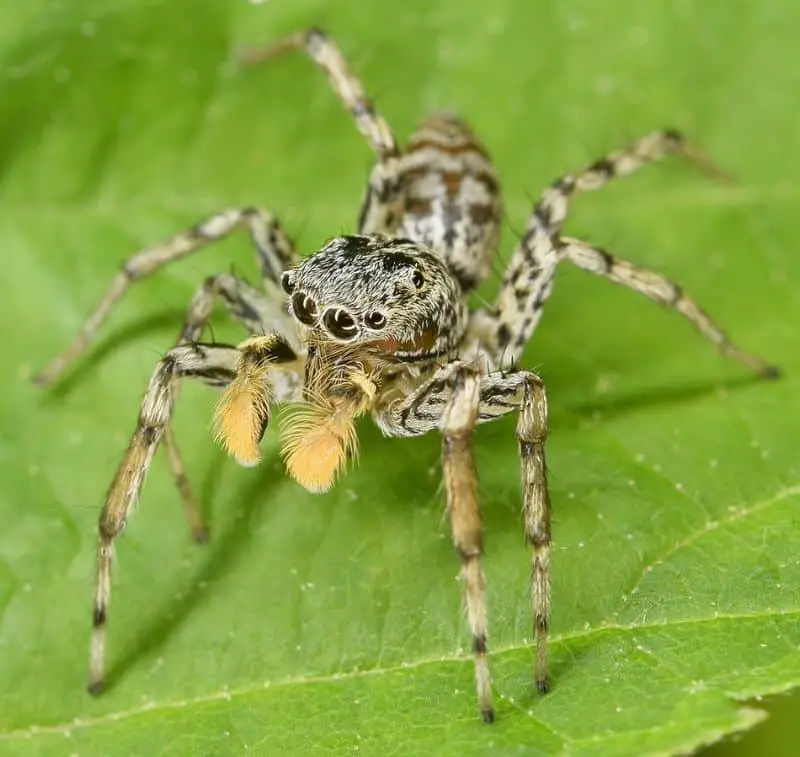
Around 50% of all males are dark morphs while the other 50% are gray morphs.
The female Maevia inclemens has a brown body and legs with white and red markings on the back of its abdomen.
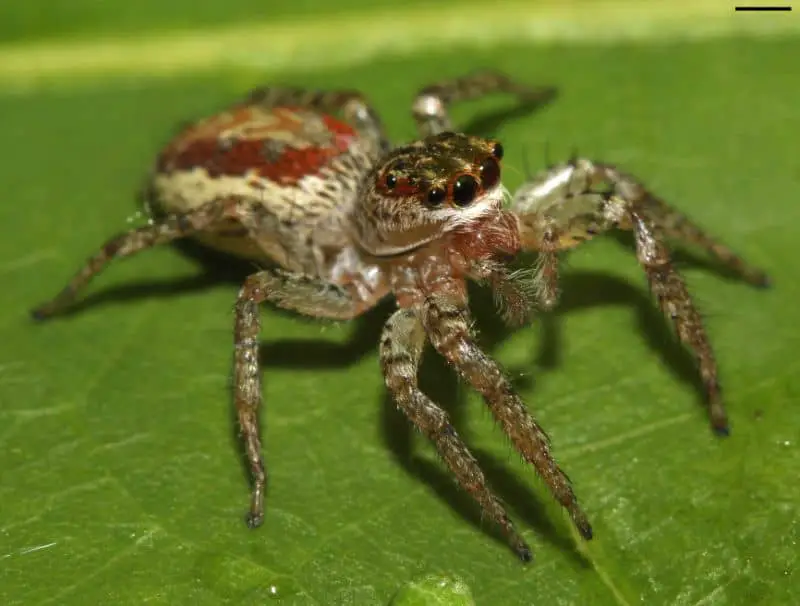
Size
The dimorphic jumper is, like other jumping spiders, a rather small spider. They reach a size of 0.2-0.3 inches (0.5-1.0 cm). Females are around 20% larger than males.
Web
Like all jumpings spiders, the dimorphic jumper is a hunting spider and doesn’t spin a web to catch prey. It only uses its ability to create silk to drag a safety line for dangerous jumps. In case the jump goes wrong, the spider will be stopped by the silk string.
Bite
A Maevia inclemens bite is not dangerous for humans. They are also very shy and incredibly fast spiders – so it is unlikely to be bitten by one. In case a bite occurs, minor swellings can be expected. The level of pain is much less than that of a bee sting.
Scientific Classification of Maevia inclemens
- Kingdom: Animalia
- Phylum: Arthropoda
- Subphylum: Chelicerata
- Class: Arachnida
- Order: Araneae
- Infraorder: Araneomorphae
- Family: Salticidae
- Genus: Maevia
- Species: Meavia inclemens
Common Names
Dimorphic jumper or dimorphic jumping spider.
Distribution of the dimorphic jumping spider in the USA
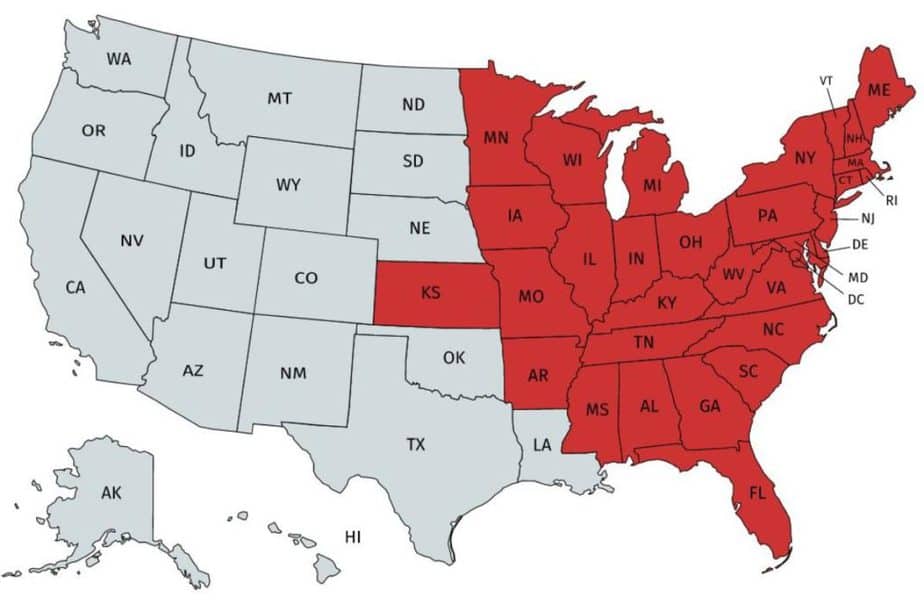
The dimorphic jumper is a quite common species throughout the Eastern United States and is mostly found in the following states: Alabama, Arkansas, Connecticut, Delaware, Florida, Georgia, Illinois, Indiana, Iowa, Kansas, Kentucky, Maine, Maryland, Massachusetts, Michigan, Minnesota, Mississippi, Missouri, New Hampshire, New Jersey, New York, North Carolina, Ohio, Pennsylvania, Rhode Island, South Carolina, Tennessee, Vermont, Virginia, West Virginia, Wisconsin

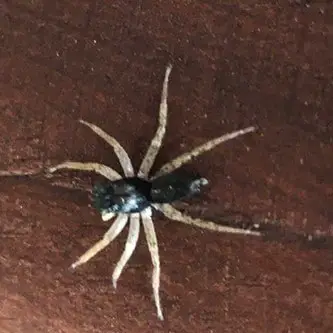
Found in Alexandria, LA.
Hello Jeremi,
This is a female dimorphic jumping spider (Meavia inclemens: http://usaspiders.com/maevia-inclemens-dimorphic-jumper/)
On the dining room table for several days now. Appears much less brown or more pale/white/cream in this photo than in situ. Very thirsty, gave him a big droplet to drink!
Hello Neil, thanks for getting in touch! This is a female dimorphic jumping spider (Maevia incelemens): https://usaspiders.com/maevia-inclemens-dimorphic-jumper/
Okay but how could you bypass the fact that the dark morph also has these three cartoonish spikes on their head?? It’s my favorite thing about these guys, and I always try to see if I can get a picture of that funky little hairdo when I find one.
Hi Lily, thanks for this awesome shot! You are right 🙂 we will add that information to the post along with your picture to help others identify them more easily! Thanks!
This was found right outside my doorstep on the bottom side of my roofing in centeral Oklahoma, just curious if it is a type of jumping spider (tan jumping spider?) because I’ve been wanting to keep one as a pet, and it’s been hanging out there for the past few days, thanks for any information.
Hi Tyler, this is a female dimorphic jumper (Maevia inclemens): https://usaspiders.com/maevia-inclemens-dimorphic-jumper/
This little guy has been clinging to my window screen (in Arlington VA) for about a week. It’s maybe a half an inch, maybe a little longer and appears to be solid black. What’s funny is that when I go over to take a closer look at it, it scrambles around. Otherwise it stays stationary.
Hi Melissa, this is a male jumping spider. Due to the contrast on the image, I am not 100 % positive on the species. Due to the colouration of body and legs, however, I guess that this is a dimorphic jumper (Maevia inclemens): https://usaspiders.com/maevia-inclemens-dimorphic-jumper/
male dimorphic jumper on a bike tire
Fast, shy, and very aware of my presence
May 13, 2024
SW Ohio